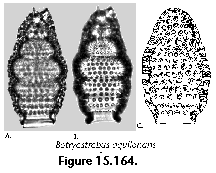 |
Botryostrobus aquilonaris
(Bailey) (Figure 15.164) [=Lithocampe aquilonaris].
Very thick-walled, spindle-shaped skeleton with 6 poorly
defined joints, of which the fourth is the broadest.
Poreless peristome usually present. Shell height: 100-150
Ám. Ref: Nigrini and Moore
(1979). |
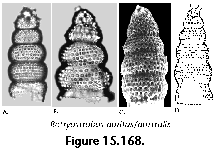 |
Botryostrobus
auritus/australis (Ehrenberg) (Figure 3J; 15.168). [=Lithostrobus seriatus].
Multisegmented cylindrical shell of variable
wall-thickness. Cephalis subspherical, apical tube and
apical spine usually visible. Thorax and post-thoracic
segments inflated, separated by conspicuous strictures,
with three-five transverse rows of pores. Shell height:
110-200 Ám. Ref: Boltovskoy and
Vrba (1989). |
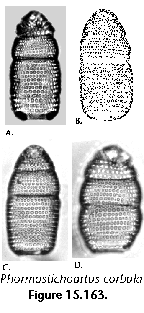 |
Phormostichoartus corbula
(Harting) (Figure 15.163) [=Lithocampe multiseriata, Siphocampe
corbula]. Four-segmented shells. Cephalis and thorax
fused, thick-walled. Abdomen short, cylindrical. Last
segment usually three-four times longer than previous,
both with circular pores arranged regularly in transverse
rows. Shell height: 130-170 Ám. Ref: Nigrini and Moore
(1979). |
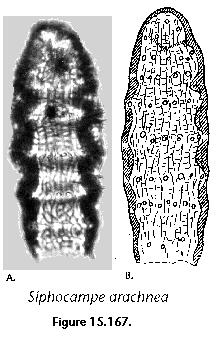 |
Siphocampe arachnea (Ehrenberg) (Figure 15.167) [=Lithomitra arachnea].
Cylindrical shell with three-eight joints, with four
transverse rows of small, circular pores on the thorax
and one on each subsequent segment. Surface covered with
a typical net of irregular longitudinal and transverse
ridges. Shell height: ca. 60-90 Ám. Ref: Petrushevskaya (1967). |
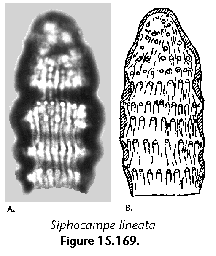 |
Siphocampe lineata (Ehrenberg) (Figure 15.169) [=Lithomitra lineata, Lithomitra
nodosaria, Siphocampe nodosaria]. Very similar
to S. arachnea, except that surface ornamentation
is restricted to longitudinal, sinuous ridges. Shell
height: ca. 80-110 Ám. Ref: Petrushevskaya (1967). |
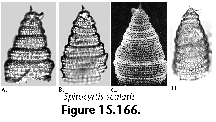 |
Spirocyrtis scalaris Haeckel group? (Figure 15.166) [=Spyrocyrtis
scalaris/cornutella]. Thin-walled shell composed of
up to 8 joints with a typically angular outline
increasing step-wise in width toward the base. Pores on
post-thoracic segments quadrangular, arranged in very
regular transverse rows. Shell height: 100-200 Ám. Ref: Nigrini (1967), Petrushevskaya
(1971a). |
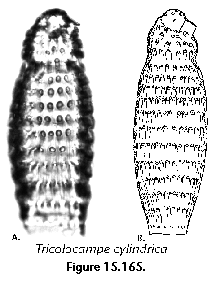 |
Tricolocampe cylindrica Haeckel (Figure 15.165) [=Siphocampium cylindrica].
Cephalis and thorax fused, separated from rest of shell
by a conspicuous lumbar constriction. Abdomen and
postabdominal section cylindrical to spindle-shaped,
without external constrictions, with several very
regularly arranged transverse rows of small, circular
pores. Shell height: ca. 90 Ám. Ref: Benson (1966), Pterushevskaya
(1971a). |






